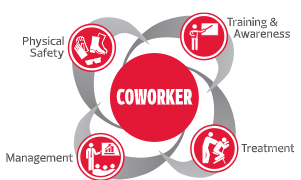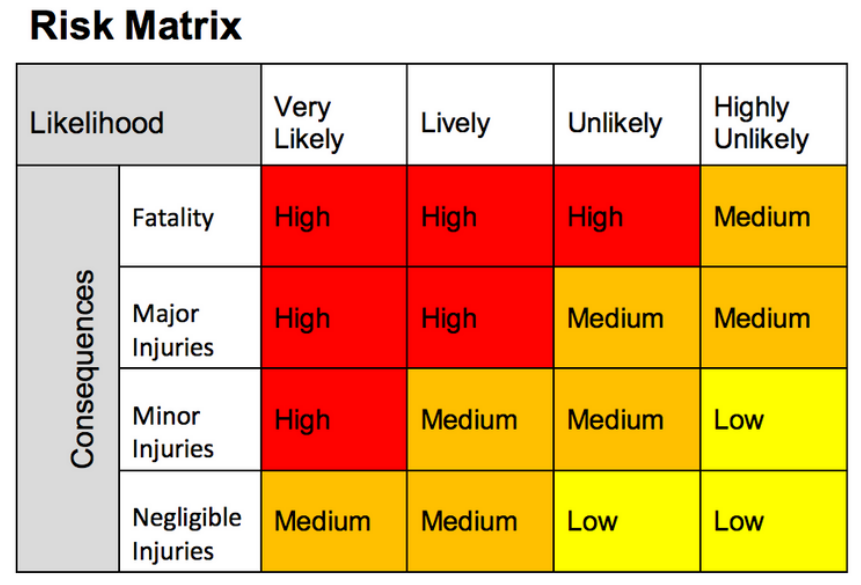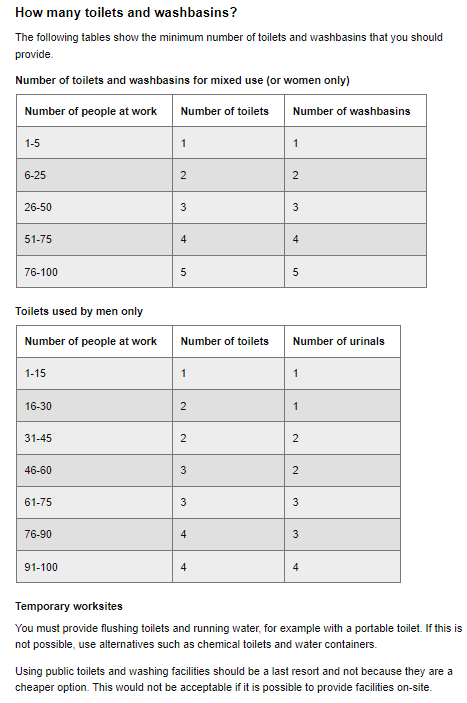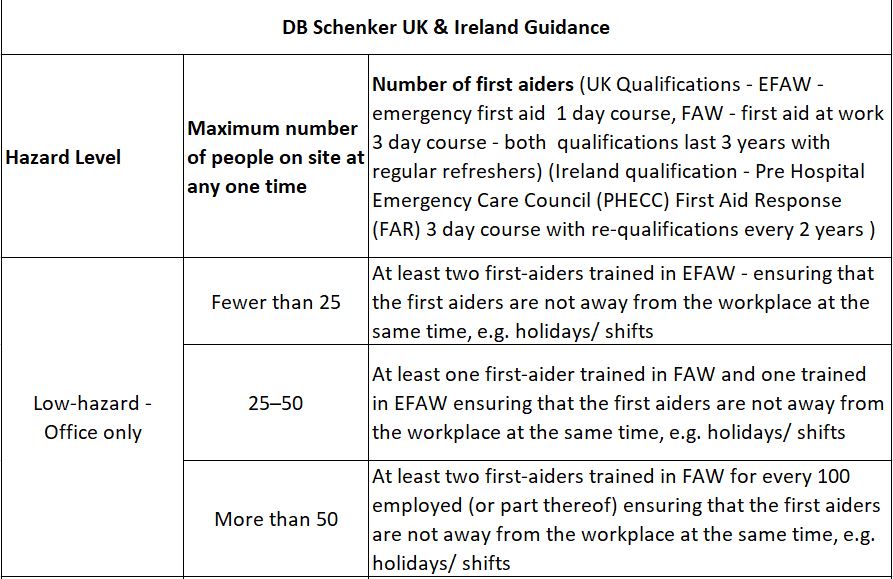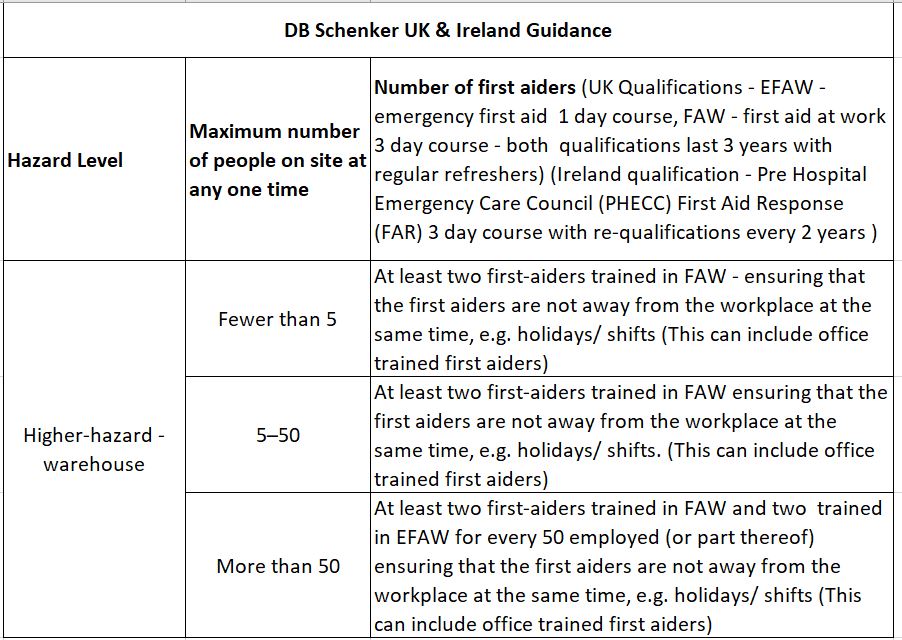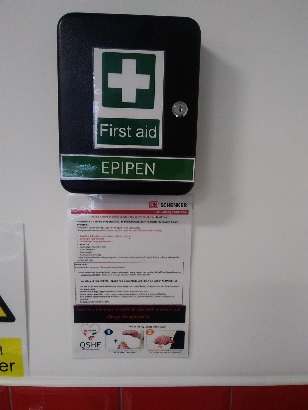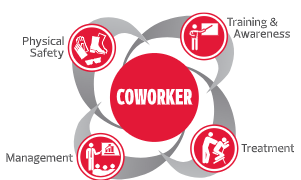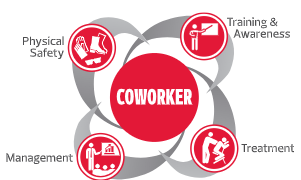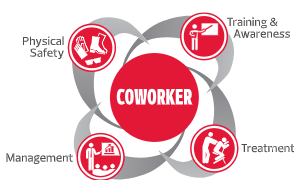Information
-
Warehouse Name
-
Address
-
How large is the warehouse? (describe, sq ft, made up of # buildings etc.)
-
How many entrances to the warehouse are there?
-
About how many coworkers work at this location?
-
Conducted on
-
Prepared by
References
-
Risk Matrix Reference
-
Hierarchy of Controls Reference
General Safety
General Safety
-
Dress code being followed (No open toed shoes, no rings, no watches, necklaces tucked in, etc. Is there a dress code stated at the entrance/what is the dress code-add notes)
-
Employees performing physical work have adequate periodic rest breaks to avoid fatigue levels that could result in greater risk of accidents and reduced quality of work.
-
PPE (Hearing protection, gloves, etc.) provided and worn when required
Workplace Facilities
Workplace Facilities
-
Are there sufficient toilet facilities near to work areas,with separate hand washing facilities and an adequate supply of hot water, soap or hand cleaners?
-
-
Are toilet and washing facilities regularly cleaned and in a sanitary condition?
-
Is a clean locker room provided for changing clothes,with facilities for separating soiled working clothes from personal clothing?
-
Is there a comfortable separate room for workers to take rest breaks?
-
Is there a separate rest room (or area of the rest room)for nonsmokers?
-
Is there a rest room for pregnant women and nursing mothers,near to sanitary facilities and with somewhere to lie down?
-
Is there an adequate supply of fresh drinking water?
-
Is there a separate,hygienic and comfortable eating area which is adequate for the numbers employed?
RIDDOR-Reporting of Injuries, Diseases and Dangerous Occurrences Regulations
Coworker injury cases
-
Who handles/tracks injury cases?
-
Who are injuries reported to?
-
What system is used to document injury cases?
-
How is insurance handled/Is there employer liability insurance? Through Who?
-
How are corrective actions and preventative action tracked?
-
Is management involved/do they know the safety records
-
Are goals/incentives in place to promote safety?
Safety Training
-
How is Safety training conducted?
-
Who conducts Safety Training?
-
What kind of Safety Training is provided and when?
-
Do new hires receive Safety Training and what does that entail?
Housekeeping and Slips, Trips & Falls
Housekeeping
-
Are areas free of tripping hazards?
-
Are aisles free from obstructions such as skids, equipment, shelves?.
-
Are floors clean and free from slippery substances such as water, oil, etc?
-
Are scrap metal, glass, knife blades deposited in the proper containers?
HOUSEKEEPING AND WASTE MATERIALS
-
Take a photograph of the area inspected.
-
Is the workplace kept generally clean and tidy? (0 - Poor / 10 - Excellent)
- 1
- 2
- 3
- 4
- 5
- 6
- 7
- 8
- 9
- 10
-
Are appropriate and convenient storage racks provided for tools, raw materials,parts and products?
-
Are oil spills and other slips, trips and fall hazards promptly cleaned up or removed?
-
Are all work areas cleaned and tidied up daily (or more frequently if necessary),with all hazardous waste materials disposed of properly?
-
Are there enough waste receptacles or containers of adequate size?
-
Is there provision for proper drainage of waste water or other liquids?
Falls from height
FALLS OR FALLING OBJECTS
-
Are all staircases secure and fitted with suitable handrails?
-
Exposed or open loading dock doors and other areas that employees could fall 4 feet or more or walk off should be chained off, roped off or otherwise blocked.
-
Are ladders,platforms,crawling boards and other equipment for working at heights in good repair and suitable for the task?
-
Are materials and objects adequately stored or stacked to prevent them from falling and causing injury?
-
Are vehicles unloaded safely,without workers having to climb on top vehicles or loads?
-
Fall protection equipment (harnesses, lanyards, etc.) inspected by a competent person once a year
-
Records kept?
Operation of lift trucks/Material Handling
Operation of Lift Trucks/Material Handling
-
Are all containers, skids, pallets, materials, and equipment arranged neatly and orderly in assigned areas?
-
Are certified personnel operating fork lifts?
-
How are certified drivers tracked? (infolink, badge, etc.)
-
Are approved safety knives being used?
-
Approved Safety cutters
-
Are pallets properly banded or secured for shipment?
-
Are the forklifts and pallet jacks in good condition?
-
Is material stored so it does not block sprinkler heads, alarm systems, electrical panels, or access to fire extinguishers?
-
Is there adequate clearance from overhead light fixtures when placing material overhead?
-
Are pallet jacks stored in a manner that would minimize the possibility of tripping? (under load and handle turned sideways)
-
Nameplates and markings are in place and maintained in a legible condition.
-
Battery charging is conducted only in designated areas.
-
Precautions are taken to prevent smoking, open flames, sparks or electric arcs in battery charging areas (singage)
-
Forklift operators are competent to operate a vehicle safely as demonstrated by successful completion of training and evaluation conducted and certified by persons with the knowledge, training and experience to train operators and evaluate their performance.
-
Refresher training and evaluation is conducted whenever an operator has been observed operating the vehicle in an unsafe manner or has been involved in an accident or a near-miss incident.
-
How often are Evaluations of each operator’s performance conducted?
-
Load engaging means are fully lowered, with controls neutralized, power shut off and brakes set when a forklift is left unattended.
-
Operators maintain a safe distance from the edge of ramps or platforms while using forklifts on any elevated dock, platform or freight car.
-
There is sufficient headroom for the forklift and operator under overhead installations, lights, pipes, sprinkler systems, etc.
-
Operators observe all traffic regulations, including authorized speed limits. (signs in place stating caution areas or speed limit restrictions)
-
Dock plates are properly secured when loading or unloading from dock to truck.
-
Training for proper docking of trailers
-
Procedure in place for safe docking and releasing of trailer (ensure no coworkers are inside the trailer when released)
TRAFFIC ROUTES AND PASSAGE WAYS
-
Are there separate routes for pedestrians and traffic (eg fork lift trucks,etc)in the workplace?
-
Are aisles,passageways and traffic routes free from obstructions and other hazards, and clearly marked for safe movement of people, vehicles and materials?
-
Have measures been taken to prevent workers from being struck by moving materials or vehicles?
-
Are warning notices, signs or signals posted where hazardous conditions exist?
-
Are barriers placed around temporary floor openings, and used to restrict access to dangerous machines and processes?
-
Are sharp,dangerous or hot objects removed,or located so that workers cannot be hurt accidentally?
TOOLS AND EQUIPMENT
-
Are tools and work equipment suitable for the job?
-
Are tools of appropriate size,and shaped for easy and safe use?
-
Are locking devices (or similar)fitted to tools to reduce gripping or handling force and vibration?
-
Are all tools and equipment kept in good repair and properly maintained?
-
Has the location where the equipment or tools are being used been assessed to identify any particular risks which may arise? For example,working in confined spaces or a flammable atmosphere?
-
Is training provided for those who use tools and work equipment,and also for their managers and supervisors?
Machine Safety
MACHINE SAFETY
-
Take a photograph of the equipment inspected.
-
Are all moving parts of machines and equipment fitted with appropriate guards?
-
Are all machinery guards securely fastened to the machines?
-
Do machines have safety cut-out switches or other safety devices to prevent the operation of machines while workers hands are in danger?
-
Can emergency stop controls be easily reached by all machine operators?
-
Are safety devices and controls regularly checked,and the machines properly maintained to ensure safe working?
-
Is maintenance work carried out safely,and machinery maintenance logs kept up to date?
Electrical Safety
ELECTRICAL SAFETY
-
Are there any exposed, loose or entangled wires or connections?
-
Are all switchboxes,panel boards and sockets provided with suitable covers?
-
Is all electrical equipment effectively earthed?
-
Is all electrical equipment regularly inspected for signs of wear and tear?
Environmental
LIGHTING
-
Are all areas of the workplace, including relevant outside areas adequately lit?
-
Have excessive glare and reflections been eliminated?
-
Are workstations properly positioned to make the best use of natural light?
-
Is local lighting provided to workstations where necessary?
-
Is emergency lighting provided,with an independent power source which activates automatically when normal lighting fails?
-
Does emergency lighting provide enough light?
NOISE
-
Is the workplace too noisy?
-
Is noise reduced at source by the provision of properly designed,well maintained and adjusted tools or machines?
-
Are noise levels reduced by the use of sound-absorbent materials?
-
Can the source of any excessive noise be enclosed or isolated?
-
Is suitable hearing protection provided if noise levels cannot be reduced by any other means?
TEMPERATURE,VENTILATION &EXTRACTION
-
Workplace not too hot or too cold
-
Measures can be taken to control temperature extremes
-
Enough natural ventilation in the workplace, e.g. windows or open doorways
-
If natural ventilation is insufficient, are ventilators, fans or air conditioners provided to ensure a consistent flow of fresh air
-
Machinery and equipment which generates heat or fumes isolated or enclosed
-
Adequate extraction systems fitted to machinery or equipment, or is local exhaust ventilation provided where necessary
-
Ventilation and extraction systems regularly cleaned and maintained to ensure their efficiency
COSHH (Control of Substances hazardous to health)
Hazardous substances
-
Have all substances used in the workplace been assessed and adequately controlled under the COSHH Regulations?
-
Have safer materials and substances been substituted where possible?
-
Are dust or fume producing machines enclosed or isolated?
-
Are sources of hazardous gases or vapours completely enclosed or sealed?
-
Is local exhaust ventilation adequate? Is it regularly cleaned and maintained?
-
Is suitable protective equipment provided where exposure cannot be controlled by other means?
HANDLING AND HAZARDOUS MATERIALS
-
Is work organised to eliminate or minimise the handling of hazardous materials?
-
Where direct handling is unavoidable, are workers provided with suitable personal protective equipment,clothing and gloves?
-
Are there emergency procedures and facilities for dealing with chemical spillages and other accidents?
-
Are all hazardous substances and materials properly labelled?
-
Is suitable protective equipment provided with the full information, instruction and training on the hazards of the materials?
PROTECTIVE EQUIPMENT
-
Has the need to use personal protective equipment been minimised by the introduction of other risk control measures?
-
Is the protective equipment provided (eg safety glasses, face shields, masks,ear defenders, safety footwear,helmets,gloves, etc)suitable for the task?
-
Has all protective equipment which is used only at work been provided at no cost to the worker?
-
All protective equipment in good condition and well maintained? - Insert Photograph of PPE inspected
-
Have all workers who use personal protective equipment been provided with full information on the risks they are being protected from,and given instruction and training on proper use of the equipment?
Fire Safety
Fire Safety
-
Are fire extinguishers available, not blocked and in good condition?
Tap to enter information
-
Check the inspection tag.
-
Are packing material, cardboard and paper properly and promptly disposed of?
-
Pull stations are properly housed.
-
Fire Risk Assessments completed/documented? All potential fire hazards addressed and mitigation measures taken
Emergency Management & Response
-
Designated Severe Weather Shelter Areas exist (Away from windows, external walls, clearly marked)?
-
Are there designated Emergency Response Team (ERT) members?
-
Is the ERT up to date and accurate with who is on site?
-
All emergency exits are lit and properly marked?
-
Coworkers know and are trained on the evacuation procedures?
-
Emergency Maps posted and up to date?
-
Designated Evacuation Assembly area(s)? Located at safe distance(s)?
-
Emergency contact list up to date?
-
Last time the facility had a drill?
Facility Information and First Aider requirements
-
Type of facility and risk level.
-
Office facilities are deemed "Low-Hazard" according to HSE Guidance. Taking this into consideration - the following requirements are required by in office based facilities. ( UK terminology - EFAW - emergency first aid 1 day course, FAW - first aid at work 3 day course - both qualifications last 3 years with regular refreshers.)
-
Maximum number of people on site at any one time (please consider visitors and guests)?
-
At least two first-aiders trained in EFAW - ensuring that the first aiders are not away from the workplace at the same time, e.g. holidays/ shifts.
-
Are there sufficient and suitable trained staff to cover the needs of the site?
-
Site management should make immediate arrangements for suitable staff members to be trained to a suitable level depending on the needs of the site
-
List the names of first aiders here
-
At least two first-aiders trained in EFAW - ensuring that the first aiders are not away from the workplace at the same time, e.g. holidays/ shifts
-
Are there sufficient and suitable trained staff to cover the needs of the site?
-
Site management should make immediate arrangements for suitable staff members to be trained to a suitable level depending on the needs of the site
-
List the names of first aiders here
-
At least one first-aider trained in FAW and one trained in EFAW ensuring that the first aiders are not away from the workplace at the same time, e.g. holidays/ shifts
-
Are there sufficient and suitable trained staff to cover the needs of the site?
-
Site management should make immediate arrangements for suitable staff members to be trained to a suitable level depending on the needs of the site
-
List the names of first aiders here
-
At least two first-aiders trained in FAW for every 100 employed (or part thereof) ensuring that the first aiders are not away from the workplace at the same time, e.g. holidays/ shifts
-
Are there sufficient and suitable trained staff to cover the needs of the site?
-
Site management should make immediate arrangements for suitable staff members to be trained to a suitable level depending on the needs of the site
-
List the names of first aiders here
-
At least two first-aiders trained in FAW for every 100 employed (or part thereof) ensuring that the first aiders are not away from the workplace at the same time, e.g. holidays/ shifts
-
Are there sufficient and suitable trained staff to cover the needs of the site?
-
Site management should make immediate arrangements for suitable staff members to be trained to a suitable level depending on the needs of the site
-
List the names of first aiders here
-
Facilities with a warehouse are deemed "Higher-Hazard" according to HSE due to the nature of work that occurs (Use of Machinery, FLT/PPT's, Movement of Dangerous Goods etc). Taking this into consideration - the following requirements are required in high risk facilities. (EFAW - emergency first aid 1 day course, FAW - first aid at work 3 day course - both qualifications last 3 years with regular refreshers)
-
Maximum number of people on site at any one time (please consider visitors and guests)?
-
At least two first-aiders trained in FAW - ensuring that the first aiders are not away from the workplace at the same time, e.g. holidays/ shifts (This can include office trained first aiders)
-
Are there sufficient and suitable trained staff to cover the needs of the site?
-
Site management should make immediate arrangements for suitable staff members to be trained to a suitable level depending on the needs of the site
-
List the names of first aiders here
-
At least two first-aiders trained in FAW ensuring that the first aiders are not away from the workplace at the same time, e.g. holidays/ shifts. (This can include office trained first aiders)
-
Are there sufficient and suitable trained staff to cover the needs of the site?
-
Site management should make immediate arrangements for suitable staff members to be trained to a suitable level depending on the needs of the site
-
List the names of first aiders here
-
At least two first-aiders trained in FAW ensuring that the first aiders are not away from the workplace at the same time, e.g. holidays/ shifts. (This can include office trained first aiders)
-
Are there sufficient and suitable trained staff to cover the needs of the site?
-
Site management should make immediate arrangements for suitable staff members to be trained to a suitable level depending on the needs of the site
-
List the names of first aiders here
-
At least two first-aiders trained in FAW and two trained in EFAW for every 50 employed (or part thereof) ensuring that the first aiders are not away from the workplace at the same time, e.g. holidays/ shifts (This can include office trained first aiders)
-
Are there sufficient and suitable trained staff to cover the needs of the site?
-
Site management should make immediate arrangements for suitable staff members to be trained to a suitable level depending on the needs of the site
-
List the names of first aiders here
-
At least two first-aiders trained in FAW and two trained in EFAW for every 50 employed (or part thereof) ensuring that the first aiders are not away from the workplace at the same time, e.g. holidays/ shifts (This can include office trained first aiders)
-
Are there sufficient and suitable trained staff to cover the needs of the site?
-
Site management should make immediate arrangements for suitable staff members to be trained to a suitable level depending on the needs of the site
-
List the names of first aiders here
-
Are any of the trained First Aider's due for a training refresher course in the next 12 months
-
Site management should arrange refresher training or identify an alternative staff member for this role.
-
Are the evacuation posters (including locations of First Aid Kits) displayed around the facility and does the visitor leaflets have the locations of the First Aid Points displayed?
-
A Review of your posters, site maps with First Aid Kit locations, should be reviewed and when complete displayed around the site.
-
Please add images as evidence of information points.
-
Are there an adequate number of First Aid Kits/Consumables/Eye wash stations? Are they located at suitable locations determined by the activity in that area.
-
Contents of the first aid kit is based on best practice taken from BS8599. Monthly first aid checks are required to ensure the correct equipment and quantities are maintained as a minimum. (Ensuring that they are within their expiration date). Locations of First Aid Kits should be readily communicated on the Branch Emergency Plans, Evacuation Posters and visitor guides amongst others as well as physical signage within the site.
First Aid Boxes
-
First aid box(es) available and in good condition?
-
How many First Aid boxes total?
-
All first-aid boxes should have a white cross on a green background. Similarly, first-aid rooms should be easily identifiable by white lettering or a white cross on a green background.
-
Who checks the First Aid box(es)?
-
How often is the First Aid box(es) checked?
-
Sufficient supplies<br>*See Link below for First Aid Box Requirements*
-
https://www.cs-compliance.co.uk/update-british-standard-for-workplace-first-aid-kits-bs-8599-12019/#:~:text=The%20new%20standards%20(BS%208599,scissors%20and%20fewer%20triangular%20bandages.
-
First aid boxes DO NOT contain prescription or over-the-counter tablets/medications such as aspirin, Ibuprofen, decongestants, sinus relief, etc. due to not being first aid/ liability risk.
-
Is there any defective item/s?
-
Is there anything out-of-date/expired?
AEDs
-
How many AEDs total?
-
What kind of AEDs are utilized?
-
Who inspects the AEDs at the site?
-
AEDs inspected monthly and in good condition (pads not expired, no missing supplies)
Special Requirements
-
Does the facility have any high risk colleagues?
-
Staff with a lack of experience/maturity may inadvertently place themselves and others at higher risk. Staff in these circumstances must not be exposed to or be given responsibilities for higher risk activities until a suitable time allowing for training programs to be completed and experience/maturity is acquired.
-
In accordance with QSHE SOP 006 Risk Assessment Process, Form QSHE 169 Expectant mother risk assessment must be completed by competent/trained member of staff. Dependent on the type of role performed additional risk assessments (Office - QSHE 188 DSE) (Warehouse - QSHE 195a Manual Handling Assessment) must be completed. When completed, these assessments are to be shared with their line management and HR and are to be treated with high confidentiality in line with the GDPR requirements.
Health Issues
-
Are any colleagues affected by high risk health conditions
-
It is advised that those afflicted with a health condition raise this with their first aiders so that will help with preparation if they require emergency support. Colleagues with health conditions must adhere to the advice offered by medical professionals, self manage themselves with medication (if required). If there are any deterioration of a colleagues condition, they must advise staff members who will seek out First Aid assistance
-
Are any colleagues effected by higher risk health conditions?
- Asthma
- Heart conditions/ chest pains
- Seizures
- Severe allergies
- Stroke
-
Asthma. It is advised that any colleague with a asthma should inform a first aider. This could include location of any medication/ inhaler that may help the colleague during an emergency situation. If there are any deterioration of a colleagues condition, they must advise staff members who will seek out First Aid assistance.
-
Heart Condition/Chest Pains. It is advised that any colleague with a history of heart conditions should inform a first aider. This could include location of any medication that may help the colleague during an emergency situation. If there are any deterioration of a colleagues condition, they must advise staff members who will seek out First Aid assistance.
-
Seizures. It is advised that any colleague with a seizures should inform a first aider. This could include location of any medication that may help the colleague during an emergency situation. If there are any deterioration of a colleagues condition, they must advise staff members who will seek out First Aid assistance.
-
Severe allergies. It is advised that the colleague with sever allergies inform a first aider of the location of Epipen if this is required. The colleague must inform providers of external food entering the site, for example lunch orders, of their allergies . If there are any deterioration of a colleagues condition, they must advise staff members who will seek out First Aid assistance.
-
Stroke. If there are any deterioration of a colleagues condition, they must advise staff members who will seek out First Aid assistance.
Trailer Yard
-
Yard is clear of major obstructions and has clear passageways for vehicle traffic.
-
Yard is free of debris (Pallets, trash, etc.)
-
Trailer yard access is restricted.
Parking Lot
-
Is the parking lot clear of debris?
-
Are sidewalks, ramps and walking surfaces in good repair?
-
Are mirrors or STOP signs posted at blind spots?
-
Are directional signs posted, are they legible?<br>
-
Is the lot paved? Are lines & directional arrows legible?
-
Vegetation trimmed away from walkways & entrances?
-
Any tripping hazards? Curbs? Holes? Debris?<br>
-
Are there designated pedestrian walkways?
-
Designated handicapped parking spots?
-
Are ramp slopes to entrance provided?
-
Lot bumpers secured? Easily identified?
Disabilities at work (DDA)
Accessibility/Reasonable adjustments
-
Emergency preparedness policy or business continuity plan for employees and includes ways in which assistance for people with disabilities are addressed.
-
making physical changes to the workplace, like installing a ramp for a wheelchair user or an audio-visual fire alarm for a deaf person
-
Letting a disabled person work somewhere else, such as on the ground floor for a wheelchair user
-
Changing their equipment, for instance providing a special keyboard if they have arthritis
-
Walkways wide enough for wheelchair users and ramps or lifts where there is stair access.
-
Disabled toilets should also be provided for employees, clients and visitors with mobility issues. These should include an alarm system and the necessary supports and space.
-
Adjustments for employees with sight or hearing impairments. They may need a hearing loop installed on the premises, or instruction manuals for equipment copied in braille or large print.
Lone workers and Workplace Stress
-
Site conducts Stress Risk assessments
-
Staff trained to manage issues around lone working (An employee who works by themselves without close or direct supervision) and how to <br>get support
-
Managers in spotting early signs of stress and how to manage it
-
Details of employee assistance services provided for staff
-
Managers trained in promoting a positive working and safety culture
UK Required Postings
-
The Health and Safety law poster is displayed where coworkers can easily see and read it, or each coworker provided with a copy of the approved leaflet or equivalent pocket card
-
Health and Safety Policy posted
-
Employers Liability Insurance posted
-
First Aiders posted
-
Fire evacuation Arrangements posted
Visitor Safety/Security
-
Building security on site
-
What is the name of the security company?
-
Metal detectors working as intended
-
A Visitors Safety Guide Brochure available at entrance and current/up to date
-
Cameras that cover this warehouse
-
Ask GSOC if all cameras are operational (add note of what cameras are not)
Completion
-
Any other observations or recommendations
-
Full Name and Signature of the Inspector
